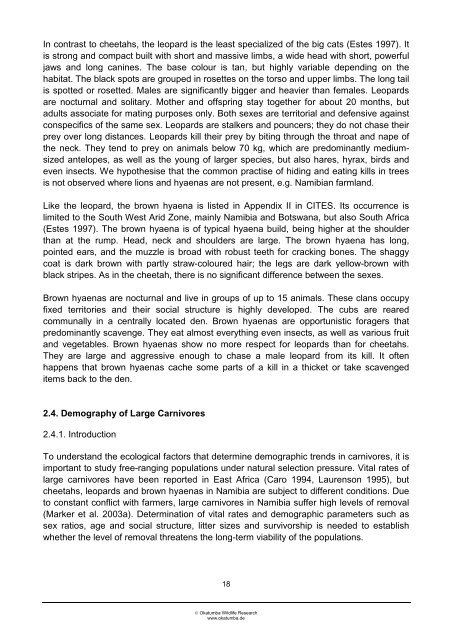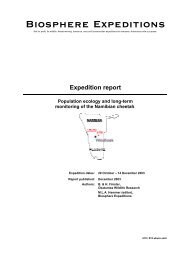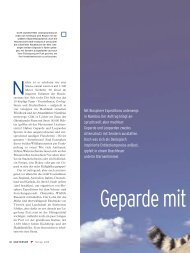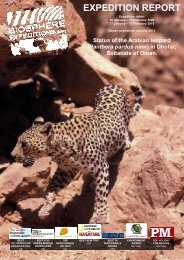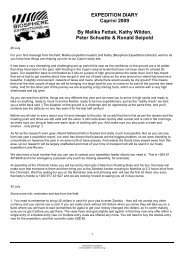EXPEDITION REPORT - Biosphere Expeditions
EXPEDITION REPORT - Biosphere Expeditions
EXPEDITION REPORT - Biosphere Expeditions
Create successful ePaper yourself
Turn your PDF publications into a flip-book with our unique Google optimized e-Paper software.
In contrast to cheetahs, the leopard is the least specialized of the big cats (Estes 1997). It<br />
is strong and compact built with short and massive limbs, a wide head with short, powerful<br />
jaws and long canines. The base colour is tan, but highly variable depending on the<br />
habitat. The black spots are grouped in rosettes on the torso and upper limbs. The long tail<br />
is spotted or rosetted. Males are significantly bigger and heavier than females. Leopards<br />
are nocturnal and solitary. Mother and offspring stay together for about 20 months, but<br />
adults associate for mating purposes only. Both sexes are territorial and defensive against<br />
conspecifics of the same sex. Leopards are stalkers and pouncers; they do not chase their<br />
prey over long distances. Leopards kill their prey by biting through the throat and nape of<br />
the neck. They tend to prey on animals below 70 kg, which are predominantly mediumsized<br />
antelopes, as well as the young of larger species, but also hares, hyrax, birds and<br />
even insects. We hypothesise that the common practise of hiding and eating kills in trees<br />
is not observed where lions and hyaenas are not present, e.g. Namibian farmland.<br />
Like the leopard, the brown hyaena is listed in Appendix II in CITES. Its occurrence is<br />
limited to the South West Arid Zone, mainly Namibia and Botswana, but also South Africa<br />
(Estes 1997). The brown hyaena is of typical hyaena build, being higher at the shoulder<br />
than at the rump. Head, neck and shoulders are large. The brown hyaena has long,<br />
pointed ears, and the muzzle is broad with robust teeth for cracking bones. The shaggy<br />
coat is dark brown with partly straw-coloured hair; the legs are dark yellow-brown with<br />
black stripes. As in the cheetah, there is no significant difference between the sexes.<br />
Brown hyaenas are nocturnal and live in groups of up to 15 animals. These clans occupy<br />
fixed territories and their social structure is highly developed. The cubs are reared<br />
communally in a centrally located den. Brown hyaenas are opportunistic foragers that<br />
predominantly scavenge. They eat almost everything even insects, as well as various fruit<br />
and vegetables. Brown hyaenas show no more respect for leopards than for cheetahs.<br />
They are large and aggressive enough to chase a male leopard from its kill. It often<br />
happens that brown hyaenas cache some parts of a kill in a thicket or take scavenged<br />
items back to the den.<br />
2.4. Demography of Large Carnivores<br />
2.4.1. Introduction<br />
To understand the ecological factors that determine demographic trends in carnivores, it is<br />
important to study free-ranging populations under natural selection pressure. Vital rates of<br />
large carnivores have been reported in East Africa (Caro 1994, Laurenson 1995), but<br />
cheetahs, leopards and brown hyaenas in Namibia are subject to different conditions. Due<br />
to constant conflict with farmers, large carnivores in Namibia suffer high levels of removal<br />
(Marker et al. 2003a). Determination of vital rates and demographic parameters such as<br />
sex ratios, age and social structure, litter sizes and survivorship is needed to establish<br />
whether the level of removal threatens the long-term viability of the populations.<br />
18<br />
� Okatumba Wildlife Research<br />
www.okatumba.de


